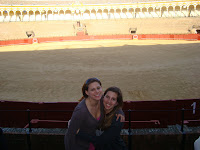It is impossible to capture Sevilla in one day (or one blog post), but here is my best attempt:
We arrived at the Sevilla bus station at 7 am, six hours after boarding the Socibus in Madrid. After stopping for some coffee and Cola Cao at the train station, we headed to Horno San Buenaventura for a delicious breakfast (just one euro!) of toast with butter and orange marmalade. Sevilla is known for its orange trees, but the oranges are bitter and essentially inedible. So, the oranges are used for "Mermelada de Naranja Amarga."

Most of the main sites didn't open until after 9:30 am, so we spent some time walking along the Guadalquivir River and admiring the Torre de Oro, a tower that once served as an anchor point for the chain that crossed the river and is now known for its golden appearance in the sunlight.

The Real Alcazar (Royal Palace) of Sevilla, constructed with both Muslim and Christian cultural/architectural influences, is still used today by the Royal Family as their main Seville residence.
We visited the Catedral, which is Spain's largest cathedral and the home to Christopher Columbus' tomb. It reminded me a lot of every other cathedral that we have seen but with one unique addition: "La Giralda," the bell tower. We climbed (the ramp) to the top and took in some incredible panoramic views of the city (as the bell rang above my head)!



We then crossed the bridge to Calle Betis, a street the runs parallel to the river, for a sunny lunch and some Tinto de Verano along the water! My senora had packed me two bocadillos (baguettes) to go, so I wasn't very hungry, but I was disappointed to find out that Sevilla's well-known Gazpacho is only served during the summer season. After lunch we continued to the Triana area and Calle San Jacinto, which is known for its abundance of ceramica stores. Unfortunately, we arrived around 2 pm as they were all closing for siesta.

After returning to the Santa Cruz Barrio (the Old Jewish Quarter) in search of some ice cream, we were let down once again upon finding out that the well-known Rayas Heladeria (ice cream place) was closed for the season. After some searching, we managed to find a delicious substitute (chocolate truffle gelato) to enjoy near the Plaza del Salvador, which was full of local Sevillanas.
Heading towards the bullfighting museum, we stopped multiple times for some pastries and turron! We took a tour of the Plaza del Toros, Sevilla's large bullring and adjacent museum, and learned a lot about the culture of the "toreros." The large oval ring seats 1400 spectators in one of three "areas": sol (sun), sombra (shade), or sol y sombra. The most expensive seats are in the first three rows of the "sombra" area, and that is where the majority of the action occurs. The museum, chronologically divided into four rooms, displayed the heads of bulls who "put up a good fight," the "capotes" (capes) of famous bullfighters, and other artwork.


We ended the day with tapas and drinks on the famous Calle Mateas Gago. On our way there, we came across a group of men practicing for the Semana Santa Parade; Sevilla is known for its huge celebrations during Semana Santa and the Feria de Abril!

We enjoyed gourmet tapas at Cerveceria Giraldo (peppers stuffed with chicken) and Bodega Santa Ana (pincho de pollo). Before heading back to the bus station, we returned to Horno San Buenaventura for some baklava, cheesecake, and disaronno to end the night.

The narrow, winding streets of the historical Sevilla reminded me a lot of its neighbor, Granada, and I really enjoyed the reprieve from the bustling Madrid!



No comments:
Post a Comment